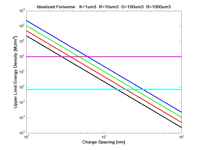
Dept. of Electrical and Systems Engineering, Washington University, Saint Louis, Missouri 63130, U.S.A.
e-mail: wfp@ese.wustl.edu

 |
William F. Pickard
Dept. of Electrical and Systems Engineering, Washington University, Saint Louis, Missouri 63130, U.S.A. e-mail: wfp@ese.wustl.edu |
 |
The forisome is a protein structure of plants which, in low Ca2+ solutions, assumes a crystalline condensed conformation and, at high Ca2+, swells to a dispersed conformation; transition is attributed to electrostatic deformation of protein "modules" [1]. Forisomes could become an important smart material if the energy density of transformation exceeds 0.5 MJ·m-3. Quantitation of the forisome as a charged porous continuum permeated by electrolyte fails by orders of magnitude to achieve this energy density electrostatically; but quantitation of an individual module as a quadrupole achieves it if modules are only 2-3 nm across. However, condensed->dispersed transitions can be visualized alternatively: (i) an ionic bond near the surface of a forisome crystal dissolves to produce two bound surface charges; (ii) the anionic site bonds to Ca2+ becoming another bound cation; (iii) the cations repel each other and force their sites apart sucking in solvent; (iv) electrolyte anions are attracted, bringing with them bound water; (v) this transition propagates throughout the crystal, with incompressible imbibed electrolyte stabilizing the initial separation. Achieving 0.5 MJ·m-3 will require modules to be no larger than 10 nm in the crystal.